-
 Bitcoin
Bitcoin $117800
0.49% -
 Ethereum
Ethereum $4432
0.55% -
 XRP
XRP $3.106
1.07% -
 Tether USDt
Tether USDt $1.001
0.01% -
 BNB
BNB $835.8
1.74% -
 Solana
Solana $189.1
2.72% -
 USDC
USDC $0.9999
-0.01% -
 Dogecoin
Dogecoin $0.2302
3.65% -
 TRON
TRON $0.3485
-0.69% -
 Cardano
Cardano $0.9212
-0.91% -
 Hyperliquid
Hyperliquid $46.97
1.45% -
 Chainlink
Chainlink $22.77
5.61% -
 Stellar
Stellar $0.4284
0.82% -
 Sui
Sui $3.766
2.82% -
 Bitcoin Cash
Bitcoin Cash $583.5
-0.82% -
 Ethena USDe
Ethena USDe $1.001
0.03% -
 Hedera
Hedera $0.2512
2.78% -
 Avalanche
Avalanche $24.18
2.27% -
 Litecoin
Litecoin $120.2
2.10% -
 Toncoin
Toncoin $3.450
1.96% -
 UNUS SED LEO
UNUS SED LEO $9.412
-0.92% -
 Shiba Inu
Shiba Inu $0.00001298
2.35% -
 Uniswap
Uniswap $10.99
3.75% -
 Polkadot
Polkadot $3.962
3.09% -
 Dai
Dai $1.000
0.00% -
 Bitget Token
Bitget Token $4.643
1.38% -
 Cronos
Cronos $0.1511
-0.08% -
 Ethena
Ethena $0.7246
3.18% -
 Monero
Monero $254.9
7.90% -
 Pepe
Pepe $0.00001100
3.32%
Where does DeFi income come from? How sustainable is it?
DeFi income sources like lending, yield farming, staking, liquidity mining, trading fees, and insurance vary in sustainability, influenced by market dynamics and platform success.
May 15, 2025 at 08:35 pm
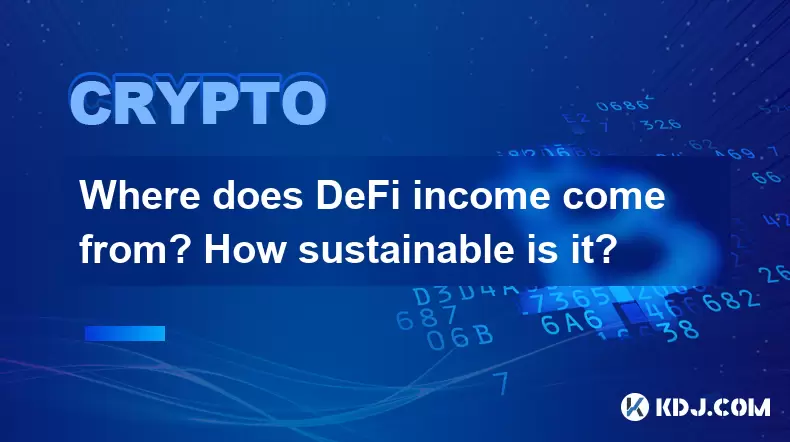
DeFi, or Decentralized Finance, has become a significant part of the cryptocurrency ecosystem, offering users various ways to earn income. Understanding where this income comes from and assessing its sustainability are crucial for anyone looking to engage with DeFi platforms. This article delves into the sources of DeFi income and examines the sustainability of these earnings.
Lending and Borrowing
One of the primary sources of income in DeFi is through lending and borrowing protocols. Platforms like Aave and Compound allow users to lend their cryptocurrencies and earn interest. The interest rates are determined by the supply and demand dynamics of the platform. Borrowers pay interest to lenders, which becomes the income for those who supply the funds.
The sustainability of income from lending and borrowing depends on several factors. Interest rates can fluctuate, and if they drop significantly, the income potential decreases. Additionally, the risk of defaults or liquidations can impact the sustainability of earnings. However, as long as there is a demand for borrowing and a supply of lending, this model can remain viable.
Yield Farming
Yield farming is another popular method for generating income in DeFi. Users provide liquidity to decentralized exchanges (DEXs) like Uniswap and SushiSwap and earn rewards in the form of tokens. These rewards are often the native tokens of the platforms, such as UNI or SUSHI.
The sustainability of yield farming income is more volatile compared to lending and borrowing. The value of the rewards tokens can fluctuate, and the annual percentage yields (APYs) can change rapidly. Additionally, the competition among different yield farming opportunities can lead to a dilution of rewards over time. However, as long as there are new projects and platforms offering attractive yields, this method can continue to be a source of income.
Staking
Staking is a process where users lock up their cryptocurrencies to support the operations of a blockchain network and earn rewards. Platforms like Ethereum 2.0 and Tezos allow users to stake their tokens and receive staking rewards. These rewards are typically distributed based on the amount staked and the duration of the stake.
The sustainability of staking income depends on the health and growth of the underlying blockchain network. If the network grows and the demand for staking increases, the rewards can remain sustainable. However, if the network faces issues or if the rewards decrease over time, the income potential can be affected. Staking is generally considered more stable than yield farming but less so than lending and borrowing.
Liquidity Mining
Liquidity mining is a strategy where users provide liquidity to a protocol and earn tokens as rewards. Projects like Curve and Balancer use liquidity mining to incentivize users to provide liquidity to their pools. The rewards are often in the form of governance tokens, which can be used to influence the direction of the protocol.
The sustainability of liquidity mining income is closely tied to the success and adoption of the protocol. If the protocol gains traction and the demand for liquidity increases, the rewards can remain attractive. However, if the protocol fails to attract users or if the rewards are diluted over time, the income potential can decrease. Liquidity mining is a more speculative source of income compared to lending, borrowing, and staking.
Trading Fees
Another source of income in DeFi comes from trading fees on decentralized exchanges. Users who provide liquidity to DEXs like Uniswap and SushiSwap earn a portion of the trading fees generated by the platform. These fees are typically a small percentage of each trade and are distributed to liquidity providers based on their share of the pool.
The sustainability of income from trading fees depends on the volume of trades on the platform. If the trading volume remains high, the income from fees can be substantial. However, if the trading volume decreases, the income potential can be affected. Trading fees are generally considered more stable than yield farming and liquidity mining but less so than lending and borrowing.
Insurance and Risk Management
Some DeFi platforms offer insurance and risk management services, where users can earn income by providing coverage for various risks. Platforms like Nexus Mutual allow users to purchase and provide coverage for smart contract risks, and those who provide coverage can earn premiums.
The sustainability of income from insurance and risk management depends on the accuracy of risk assessment and the occurrence of claims. If the premiums are set correctly and the claims are manageable, the income can be sustainable. However, if the risks are underestimated or if there are significant claims, the income potential can be affected. This method of earning income is less common but can be a viable option for those willing to take on the associated risks.
Frequently Asked Questions
Q: How can I minimize the risks associated with DeFi income?
A: To minimize risks in DeFi, diversify your investments across different protocols and strategies. Use reputable platforms with audited smart contracts, and stay informed about market conditions and potential risks. Consider using tools like stop-loss orders and regularly monitoring your positions to manage risk effectively.
Q: Are there any tax implications for earning income from DeFi?
A: Yes, income earned from DeFi activities, such as lending, borrowing, yield farming, and staking, is generally subject to taxation. The specific tax treatment can vary by jurisdiction, so it's important to consult with a tax professional to understand your obligations and how to report your DeFi income accurately.
Q: Can I automate my DeFi income strategies?
A: Yes, many DeFi platforms and third-party services offer tools to automate your income strategies. For example, you can use smart contracts to automatically reinvest your earnings or adjust your positions based on predefined criteria. However, always ensure that you understand the risks and costs associated with automation before implementing such strategies.
Disclaimer:info@kdj.com
The information provided is not trading advice. kdj.com does not assume any responsibility for any investments made based on the information provided in this article. Cryptocurrencies are highly volatile and it is highly recommended that you invest with caution after thorough research!
If you believe that the content used on this website infringes your copyright, please contact us immediately (info@kdj.com) and we will delete it promptly.
- Kazakhstan's Crypto Leap: Bitcoin ETF and Central Asia's Digital Finance Future
- 2025-08-13 12:45:19
- BlockDAG Presale Blazes Past $371M: Fundraising Frenzy Fuels Crypto Sensation
- 2025-08-13 13:05:21
- Meme Coins: Chasing the 2025 Surge – Which Will Moonshot?
- 2025-08-13 10:25:23
- Bitcoin's Wild Ride: Rally, Pullback, and What's Next
- 2025-08-13 10:25:23
- Bitcoin, Bitmax, and Institutional Demand: A New Era of Crypto Investment
- 2025-08-13 10:45:12
- Solana, ROAM, and Airdrops: What's the Buzz in 2025?
- 2025-08-13 11:35:13
Related knowledge

What is the difference between DeFi and CeFi? An article analyzing the advantages and disadvantages of both
Jun 13,2025 at 03:57am
Understanding the Foundations of DeFi and CeFiTo fully grasp the difference between DeFi (Decentralized Finance) and CeFi (Centralized Finance), it’s ...
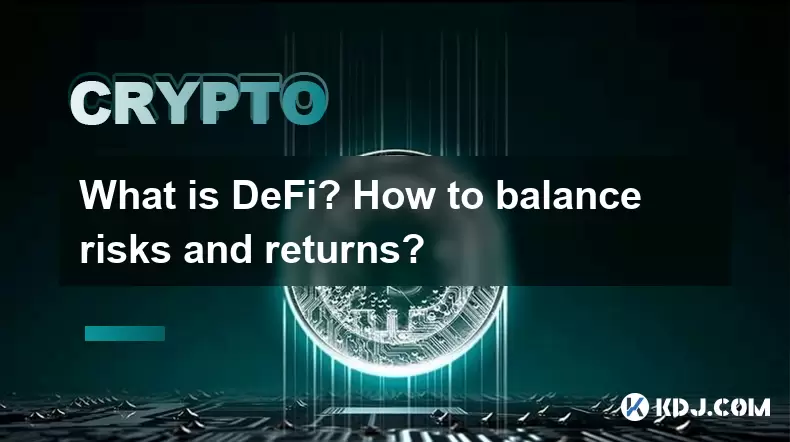
What is DeFi? How to balance risks and returns?
May 31,2025 at 12:22pm
What is DeFi? How to Balance Risks and Returns? Decentralized Finance, commonly known as DeFi, represents a revolutionary shift in the financial ecosy...
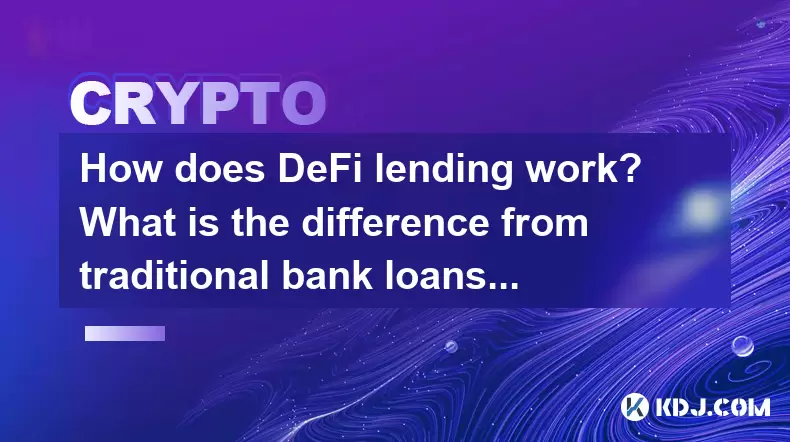
How does DeFi lending work? What is the difference from traditional bank loans?
May 29,2025 at 05:36pm
Introduction to DeFi LendingDeFi lending, or decentralized finance lending, represents a revolutionary shift in the way borrowing and lending are cond...
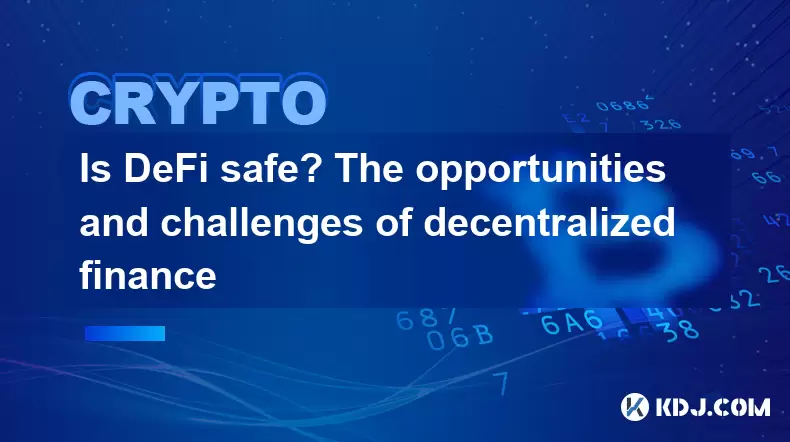
Is DeFi safe? The opportunities and challenges of decentralized finance
May 27,2025 at 02:28pm
Decentralized Finance, commonly known as DeFi, has revolutionized the financial landscape by offering a range of financial services without the need f...
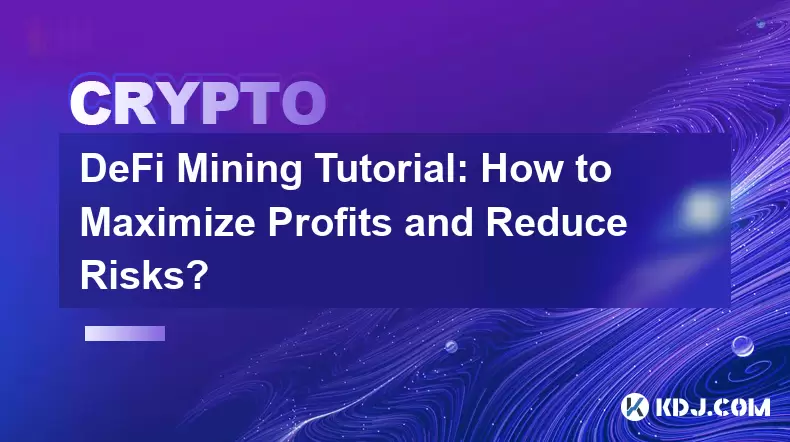
DeFi Mining Tutorial: How to Maximize Profits and Reduce Risks?
May 27,2025 at 07:42am
DeFi, or Decentralized Finance, has opened up a new world of opportunities for crypto enthusiasts looking to maximize their profits through various mi...
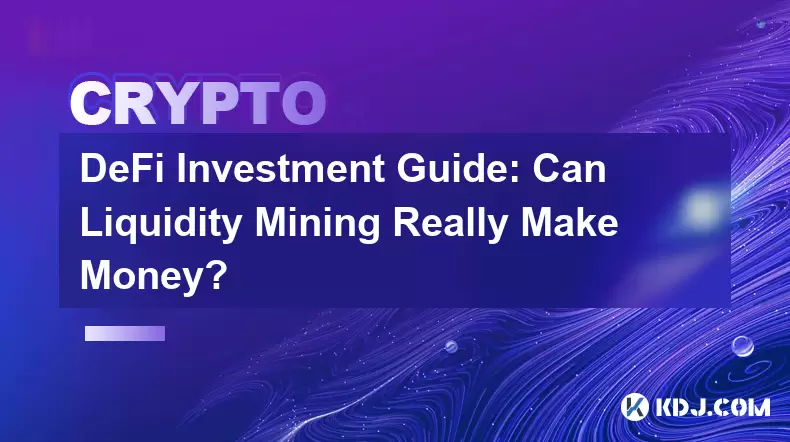
DeFi Investment Guide: Can Liquidity Mining Really Make Money?
May 28,2025 at 10:18am
Introduction to Liquidity Mining in DeFiLiquidity mining has emerged as a popular method for earning passive income within the decentralized finance (...

What is the difference between DeFi and CeFi? An article analyzing the advantages and disadvantages of both
Jun 13,2025 at 03:57am
Understanding the Foundations of DeFi and CeFiTo fully grasp the difference between DeFi (Decentralized Finance) and CeFi (Centralized Finance), it’s ...

What is DeFi? How to balance risks and returns?
May 31,2025 at 12:22pm
What is DeFi? How to Balance Risks and Returns? Decentralized Finance, commonly known as DeFi, represents a revolutionary shift in the financial ecosy...

How does DeFi lending work? What is the difference from traditional bank loans?
May 29,2025 at 05:36pm
Introduction to DeFi LendingDeFi lending, or decentralized finance lending, represents a revolutionary shift in the way borrowing and lending are cond...

Is DeFi safe? The opportunities and challenges of decentralized finance
May 27,2025 at 02:28pm
Decentralized Finance, commonly known as DeFi, has revolutionized the financial landscape by offering a range of financial services without the need f...

DeFi Mining Tutorial: How to Maximize Profits and Reduce Risks?
May 27,2025 at 07:42am
DeFi, or Decentralized Finance, has opened up a new world of opportunities for crypto enthusiasts looking to maximize their profits through various mi...

DeFi Investment Guide: Can Liquidity Mining Really Make Money?
May 28,2025 at 10:18am
Introduction to Liquidity Mining in DeFiLiquidity mining has emerged as a popular method for earning passive income within the decentralized finance (...
See all articles

























































































